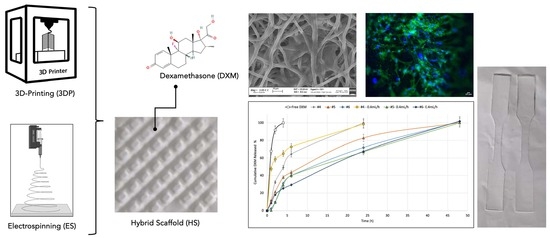Università degli Studi di Pavia - unipv.it
Hybrid 3D-Printed and Electrospun Scaffolds Loaded with Dexamethasone for Soft Tissue Applications
Background: To make the regenerative process more effective and efficient, tissue engineering (TE) strategies have been implemented. Three-dimensional scaffolds (electrospun or 3D-printed), due to their suitable designed architecture, offer the proper location of the position of cells, as well as cell adhesion and the deposition of the extracellular matrix. Moreover, the possibility to guarantee a concomitant release of drugs can promote tissue regeneration.
Methods: A PLA/PCL copolymer was used for the manufacturing of electrospun and hybrid scaffolds (composed of a 3D-printed support coated with electrospun fibers). Dexamethasone was loaded as an anti-inflammatory drug into the electrospun fibers, and the drug release kinetics and scaffold biological behavior were evaluated.
Results: The encapsulation efficiency (EE%) was higher than 80%. DXM embedding into the electrospun fibers resulted in a slowed drug release rate, and a slower release was seen in the hybrid scaffolds. The fibers maintained their nanometric dimensions (less than 800 nm) even after deposition on the 3D-printed supports. Cell adhesion and proliferation was favored in the DXM-loading hybrid scaffolds.
Conclusions: The hybrid scaffolds that were developed in this study can be optimized as a versatile platform for soft tissue regeneration.

